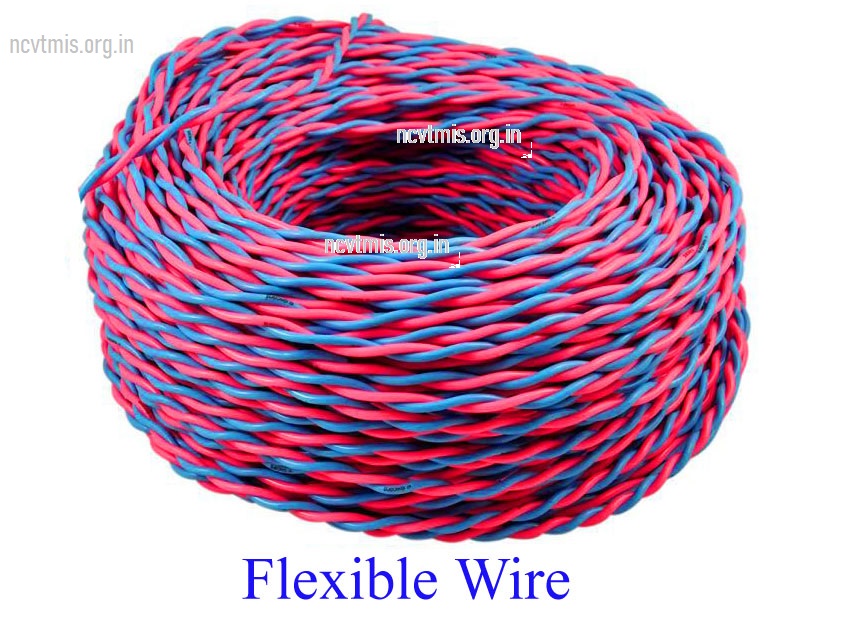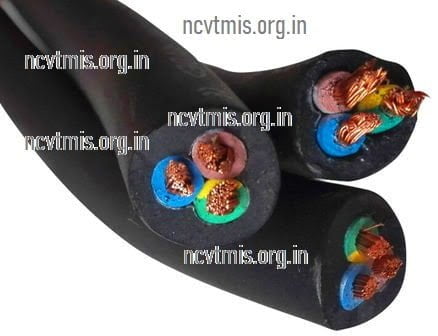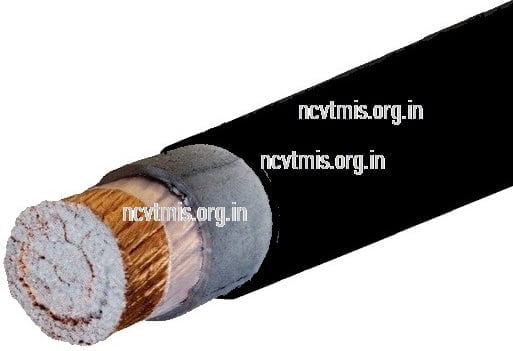A conductor without a casing or a casing insulator with a circular section providing a path for the continuous flow of electric current is called a wire or any conductor having the same diameter as the entire length and having a circular area is called a wire. Insulation is put on them later, they are called bare wire such as GI wire, earth wire, wire used in overhead line, SE wire and carton plated wire, insulated wire is called PVC plated wire. .vc wire is called
Flexible Wire

These wires are used in temporary wiring, they have many high-gauge copper wires under the PVC cover, they are used in electrical installations up to 250 V, they are used in conjunction with lamp holders to hang ceiling fans. These are used for the non-conductor of PVC.
P.V.C (Poly Vinyl Chloride) Wire

The full name of PVC is “Poly Vinyl Chloride”. At present these wires are majorly used in wiring. These PVC wires are used in homes and industries of different sizes, it is 2 mm 4 mm 6 mm and 2 mm. Comes in sizes 3/20, 3/22, 7/20, 7/22, it is used in electrical installation from 250V to 1100V.
VIR (Vulcanized India Rubber) Wire

The full name of VIR is Vulcanized India Rubber, this wire is used in wiring, its insulation is made from Indian rubber, it is used in electrical installation from 250 to 1100 volts.
Lead Sheathed Wire

These wires are covered with lead, moisture and acids do not affect them, they are mainly used in snowy areas with rain, in electrical installation it is used from 250 volts to 650 volts, its electricity The resistor is similar to the CTS wires
CTS or TRS Wire

Its full name is tuff rubber sheathed, in which flexible rubber is plated as an insulator, it is used up to 250 volts in electrical Its full name is tuff rubber sheathed, in which flexible rubber is plated as an insulator, it is used up to 250 volts in electrical installation, it is used in batten and conduct wiring, its insulation is flexible these are insulated by plating chime rubber over flexible rubber.
Weather Proof Wire

In the manufacture of these wires, naked or aluminum wire is covered with insulator like VIR wire, after which cotton tape, waterproof mixture is wrapped by applying rubber insulator, finally wax layer is applied on top of electricity. In installation, it is used up to 250 volts, it is used as a temporary power line in open environment.
Wire Used In Electric Works
Copper Wire
There are two types of copper wire
1. Hard Drawn Copper wire
2. Annealed copper wire
Hard copper is used to make overhead line wire and earthing wire while soft copper is used to make wiring wire and winding wire.
Aluminum Wire
It is used prominently in the wiring of homes or is cheaper than copper. This wire is used extensively in transmission, in overhead lines, it is light in weight, it can be standard due to its softness. Apply thimble with crimping tool
Iron Wire
The resistance of iron wire is very high, they are used more in railways, telephone lines.
G.I Wire
If the iron wires are galvanized, then they are used as earthing wire. 8 standard wire gauge and 19 standard wire gauge wires are used more.
Winding Wires
Annealed copper conductors are similar in shape: round in shape and elongated, they are of the following types
- super enamel copper wire (S.E)
- single Crystal Copper Wire (S.C.C)
- Double Cotton Cover wire (D.C.C)
- Single silk Cover copper wire (S.S.C)
- Double Silk Cover Copper Wire (D.S.C)
- PVC Cover Copper Wire Or PVC Copper Wire
Winding DCC and DSC wires are used in some DC machines. PVC plated copper wire is used in the submersible motor.
In three phase motors and transformers, super enamel wire is used in other windings.
Stranded Wire
Stranded wire Many (3,7 wires) wires are wrapped together like a rope, then it is called ‘stranded wire’. Stranded wire is attached to the overhead line, it becomes flexible and mechanically strong.
Eureka Wire
A bare wire made from an alloy prepared from the metals 60% copper and 40% nickel is called Eureka wire, this wire is used in rheostat and starter.
Nichrome Wire
A bare wire made from an alloy composed of 80% nickel and 20% chromium metals is called nichrome wire. Nichrome wire is used to make heating elements or can work safely at 1150°C. 110 at 20°C. Centimeter on micro ohm has special resistance.
Kanthal Wire
These wires are used in various ceramic works, they are used to heat steel in large furnaces, at 20 degrees centigrade, the specific resistance is 135 micro ohms per centimeter.
Current Carrying Capacity of Wires
Generally, the maximum value of electric current at temperature (at 40 degree centigrade) which can be safely passed through a wire is called the current carrying capacity of that wire.
The greater the thickness of the wire, the greater is its current carrying capacity, so the electric current produced by a wire depends on the specific resistance of the metals of that wire and its diameter and the number of standards that minimum current for a wire. The value at which the wire melts and breaks represents the value of the fusing current, the greater the thickness of the wire, the greater the value of its fusing current.
Specification of Electric wire
Specification refers to the definition in relation to the quality of the material used in a wire so that the material can be properly inspected and used in the right place. The current and voltage tolerance of the wire is determined. Usually copper or aluminum wire is used which can be of single standard or multi standard. This wire can be of different diameter and number of cores or standard such as VIR conductor. is specified in sizes 1/20, 3/22, 7/20 etc. with numerator indicating standard number while denominator denotes wire diameter
In household wiring – 3/20 copper wire for lighting
7/20 copper wire for heating
Comments are closed.